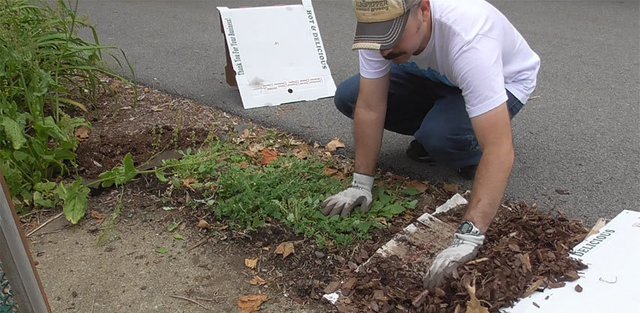Landscape Fabric Pros & Cons - Finding An Alternative Through Sheet Mulching For Weed Control...

Should you use landscape fabric? What causes it to fail? Are there any alternatives to a synthetic weed barrier? What should be considered as a long term solution?
Landscape or weed fabrics create an impassible barrier that stops the upwards growth of plants from underneath. For this barrier to work properly though, an application of mulch is needed. As a short term solution for reclaiming a weedy bed, the fabric can help you out. (It's certainly safer than using Roundup.)
Disadvantages Of Landscape Fabric...
Synthetic weed barriers can accomplish a task, but they are no silver bullet. Wood based mulches are biodegradable, so they slowly break down, forming a layer of soil. That upper layer can be a perfect rooting medium for fresh weed seeds. Before long, you may start to see that your beds are just as weedy as they were before.
All the while the microbial processes that rejuvenate your soil are being hindered by this synthetic, barrier. Earthworms and various arthropods cannot freely pass from below the soil up to the surface.
Your perennial plants become girdled as they grow wider and wider. Clumping and rhizomatous plants get trapped underneath. And creeping or layering plants cannot properly root as they get entangled in the fabric.
A Biodegradable Alternative...
A free, biodegradable alternative is simple old cardboard. This idea is a form of sheet mulching. In permaculture, sheet mulching can be done to reclaim an area of land that might have been weedy or even covered with grass.
Cardboard is applied. Then a layer of mulch. In creating a highly fertile site, a gardener may put several layers of materials. Leaves, compost, grass clippings, straw, etc. But in more conventional landscape applications, it would certainly work to just put a wood based mulch.
Weeds or grasses will be unable to pass up through the cardboard. With the inclusion of mulch you smother these unwanted plants, making way for new plantings. Over time, that cardboard is eaten by earthworms and won't interfere with biological processes.
A Longer Term Strategy...
Do you want to reduce mulching requirements? How can you keep out weeds? Nature abhors a vacuum. So your final landscape or garden should be designed in a way that fills those large empty spaces.
Plan out multiple layers of trees, bushes, shrubs and herbal plants. Allowing these to fill in your beds, choking out any weeds that make their way into your property. To cover large areas of ground, without relying on grass, consider using ground covers. Check it out below...
If you like this idea, be sure to share it with your friends and inspire someone you know. Anything becomes possible with just a little inspiration…
Posted from my blog with SteemPress : http://www.ecosnippets.com/gardening/landscape-fabric-pros-cons/
Hi! I am a robot. I just upvoted you! I found similar content that readers might be interested in:
https://www.youtube.com/watch?v=RhVcQ-uup-0